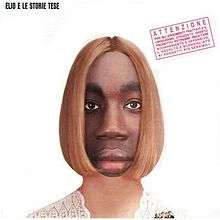Elio samaga hukapan kariyana turu
Elio samaga hukapan kariyana turu is the first album by Italian rock band Elio e le Storie Tese.
| Elio samaga hukapan kariyana turu | ||||
|---|---|---|---|---|
 | ||||
| Studio album by | ||||
| Released | December 1989[1] | |||
| Recorded | September 1989[2] | |||
| Genre | Comedy rock, hard rock, progressive rock | |||
| Length | 49:10 | |||
| Label | Psycho CBS | |||
| Producer | Otar Bolivecic[2] | |||
| Elio e le Storie Tese chronology | ||||
| ||||
The album title is in Sinhalese language, and it means "Fuck with Elio until you cum".[3]
Most of the songs featured in this record were written during the band's early years before the album's release and were often performed during the 1980s.[3]
In 2012, the album has been ranked the 15th best Italian album of all time by the magazine Rolling Stone.[4]
Title
The title of the album originated from a Sri Lankan young man living in Milan; intentioned to give an incomprehensible title to the band's debut album, Rocco Tanica – the band's pianist – asked the man to say the most possibly vulgar sentence in Sinhalese and to include the name "Elio" within it. The man replied with the title sentence, which, according to other Sri Lankan people contacted by Tanica, may also be translated as "Let's fart and cum with Elio" or "Let's blow (air) and piss with Elio".[5]
Track listing
- "Adolescenti a colloquio. Improvvisamente, Tremoto" – 1:09
- "John Holmes (Una vita per il cinema)" – 3:26
- "Domande bizzarre" – 0:39
- "Nubi di ieri sul nostro domani odierno (Abitudinario)" – 4:13
- "According the Memphis Horns" – 0:27
- "Carro – 4:45
- "Una gita a..." – 0:10
- "The Fabolous '68s According to Tony Martucci" – 0:41
- "Nella vecchia azienda agricola" – 1:29
- "Silos" – 5:18
- "Cassonetto differenziato per il frutto del peccato" – 4:04
- "Introducing the Real Parakramabahu According to Shantha Edirisinghe" – 0:25
- "Parakramabahu Rajatuma" – 0:48 (Traditional Sri Lankan song)
- "Piattaforma" – 3:29
- "Suspense! Il signor Brando Meets Marlon Brando" – 0:17
- "Introducing the Cara ti amo" – 2:33
- "Cara ti amo (Risvolti psicologici nei rapporti tra giovani uomini e giovani donne)" – 4:22
- "Messaggio satanico" – 0:38
- "Cateto" – 5:29
- "Spuma da 100" – 0:40
- "John Holmes (Shidzu Version)" – 3:38
- "Ang ang ang" – 0:21
Personnel
- Stefano Belisari as Elio – vocals
- Sergio Conforti as Confo Tanica – piano
- Davide Civaschi as Civas – electric guitar
- Nicola Fasani as Faso – bass
- Paolo Panigada as Mu Fogliasch – sax
- Curt Cress – drums
Allusions
The album contains several references to popular culture and youth culture from the 1970s and early 1980s, in particular to other music productions.
- The first track, "Adolescenti a colloquio. Improvvisamente, Tremoto", quotes the song "Eptadone" in the album MONOtono by Skiantos, as it features Elio's and Cesareo's voices electronically sped up to sound like teenage secondary school students. It also features Rockets' hit "On the Road Again" playing in background, and quotes former Italian football player Giacinto Facchetti.[3]
- "John Holmes" is dedicated to the eponymous pornographic actor.[3]
- "According the Memphis Horns" is a soundcheck by The Memphis Horns.[3]
- "Carro" is introduced by a line from "Back in the U.S.S.R." by The Beatles and contains quotes from the German national anthem.[3]
- "Nella vecchia azienda agricola" is a parody of Nella vecchia fattoria, the Italian version of "Old MacDonald Had a Farm".[3]
- "Cassonetto differenziato per il frutto del peccato" includes several quotations from Italian pop songs, such as Lucio Battisti's "I giardini di marzo", as well as a sample from Lou Reed's "The Kids".[3]
- "Piattaforma" is inspired by "Je t'aime... moi non plus" by Jane Birkin and Serge Gainsbourg.[3]
- Track 15, "Suspense! Mr. Brando meets Marlon Brando", a short spoken interlude, is a reference to La Settimana Enigmistica.[3] "Suspense!", a recurring feature, consists of a short text detailing a curious and apparently unexplainable event which happened to a man named Mr. Brando; the reader is invited to find the only possible logical explanation to the event.[6] Two more short interludes on the album, "Domande bizzarre" (English: "Weird questions") and "Una gita a..." ("A trip to..."), are also named after fixed features on the magazine.[3]
- In "Messaggio satanico" (in English "Satanic Message"), Black Sabbath are quoted. After a short speech, the song goes into an off-key rendition of Happy Birthday to You, deliberately recorded backwards. It is intended as a mockery of a 1980s trend by heavy metal and hard rock bands to include actual backmasked Satanic-themed messages and invocations on their albums, but also of the habit to look for backmasked messages even where there are actually none, as a possible further reference to "Empty Spaces" by Pink Floyd; Black Sabbath themselves, despite their lyrical themes, never used such messages.[3]
References
- "Elio Samaga Hukapan Kariyana Turu". Discografia Nazionale della Canzone Italiana (in Italian). Retrieved 23 August 2015.
- "Elio Samaga Hukapan Kariyana Turu". Discogs. Retrieved 23 August 2015.
- "Elio samaga hukapan kariyana turu". Marok (in Italian). Retrieved 23 August 2015.
- "Il miglior disco italiano? Bollicine di Vasco Rossi". Linkiesta.it (in Italian). Archived from the original on 12 March 2014. Retrieved 22 August 2015.
- Tartamella, Vito (19 December 2017). Rocco Tanica spiega le parolacce di Elio e le storie tese (in Italian).
- "Paranoia e meraviglia alla Settimana Enigmistica". Prismo (in Italian). 12 July 2016. Archived from the original on 27 September 2019. Retrieved 10 May 2020.
External links
- Elio samaga hukapan kariyana turu at Discogs
- Elio samaga hukapan kariyana turu at AllMusic. Retrieved 23 August 2015.